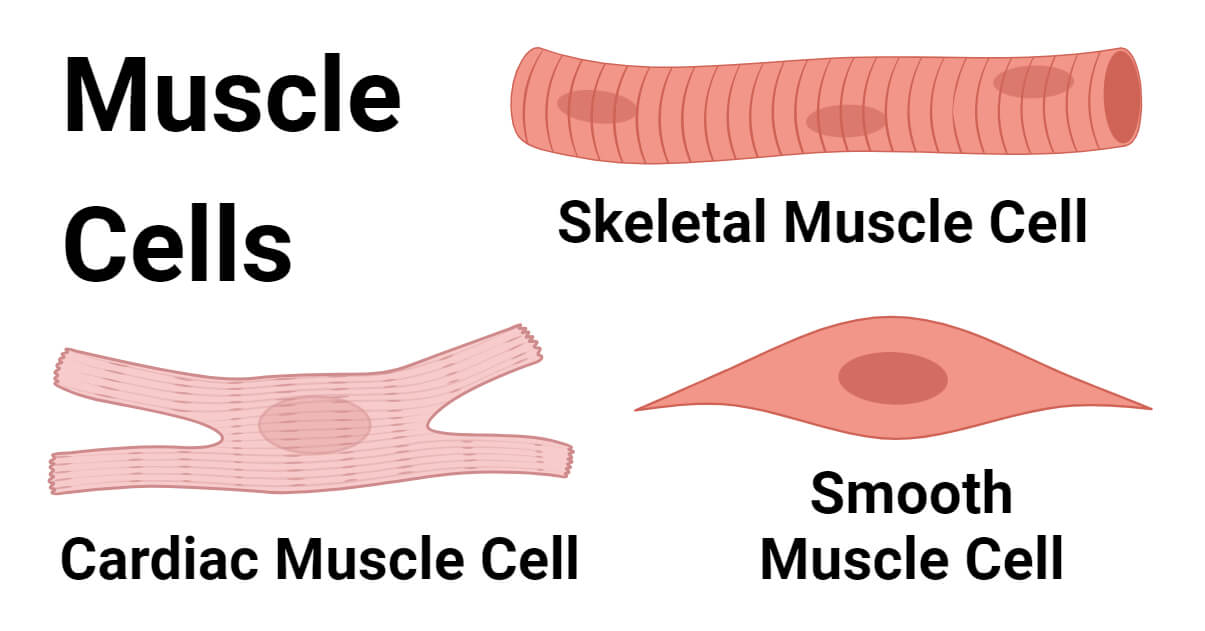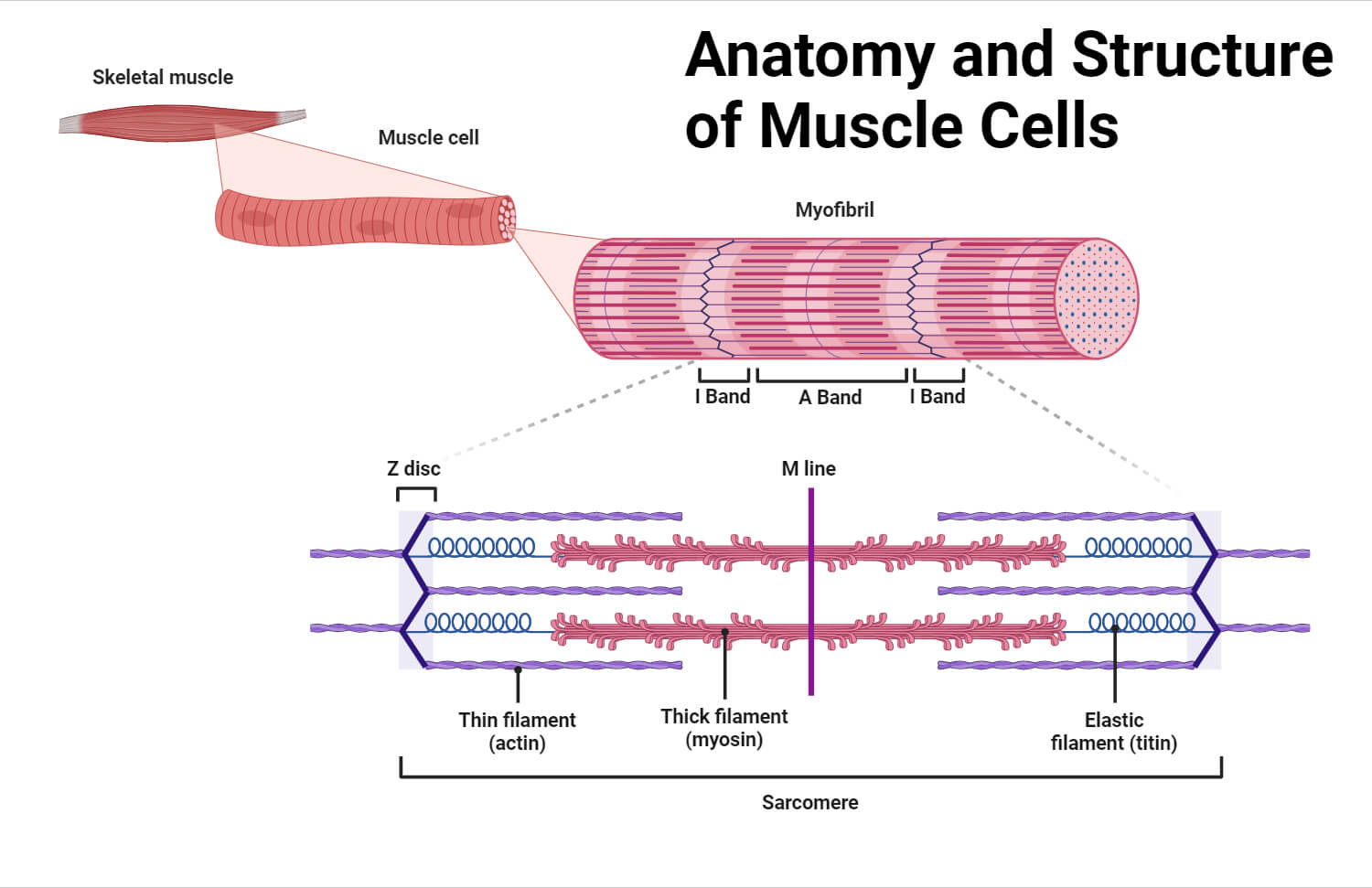Muscle cells, also called myocytes, are the basic building blocks of the muscle tissues in the body. Muscle cells drive our movement and body functions.
These cells are responsible for generating force and movement throughout the body. They are designed to contract and relax, allowing us to perform a wide range of activities, from simple gestures to difficult physical tasks.
Understanding the structure and function of muscle cells helps us to understand how our bodies move and function.
Interesting Science Videos
Types of Muscle Cells
- Skeletal muscle cells are found attached to bones and play various roles in the body, such as generating movement, supporting body posture, and regulating body temperature. They are characterized by their cylindrical shape, striated appearance under a microscope, and multinucleated structure.
- Cardiac muscle cells form the muscular tissue of the heart and are only present in the heart. They play an important role in circulating blood throughout the body. Cardiac muscle cells contract involuntarily and are controlled by the autonomic nervous system, unlike skeletal muscle cells which are under voluntary control.
- Smooth muscle cells are found in the lining of hollow organs like the stomach and blood vessels. Their contractions are also involuntary and are controlled by the autonomic nervous system. These cells are responsible for involuntary movements such as peristalsis in the digestive tract and regulating blood flow in blood vessels.

Anatomy and Structure of Muscle Cells
- The cell membrane or the outer covering of the muscle cell is called the sarcolemma. It controls the movement of substances in and out of the cell.
- The cytoplasm of the muscle cell where cellular activities take place is known as sarcoplasm. It contains the cellular components such as organelles like mitochondria and cytosol.
- Muscle cells contain long, cylindrical structures called myofibrils that are made up of repeating units called sarcomeres. Sarcomeres are composed of thick and thin filaments made of myosin and actin proteins.
- Muscle cells contain a specialized form of endoplasmic reticulum called the sarcoplasmic reticulum that is responsible for storing and releasing calcium ions necessary for muscle contraction.
- Transverse (T) tubules are intracellular tubules that penetrate the sarcolemma and wrap around the myofibrils in skeletal and cardiac muscle. T-tubules help in muscle contraction by transmitting electrical signals throughout the muscle cell.
- Skeletal muscle cells are cylindrical in shape and are striated due to the arrangement of proteins like actin and myosin. They are multinucleated, containing multiple nuclei within each cell. These cells are surrounded by layers of connective tissue and contain many mitochondria which provide the energy necessary for muscle function.
- Cardiac muscle cells are branched and also exhibit a striated appearance like skeletal muscle cells. However, they are uninucleated, meaning they contain a single nucleus in a cell. The cells are connected by specialized structures called intercalated discs, which allow rapid electrical signaling between cells. Cardiac muscle cells are smaller than skeletal muscle cells but contain abundant mitochondria for energy production.
- Smooth muscle cells are spindle-shaped and usually have a single nucleus. These cells are not striated as seen in skeletal and cardiac muscle. They have a less organized structure compared to other muscle cells and also contain fewer mitochondria.

Functions of Muscle Cells
- The main function of muscle cells is to contract and lead to the movement of body parts.
- Skeletal muscle cells are involved in voluntary body movements such as walking, running, and lifting objects. They work together to maintain posture and stability by supporting the skeletal framework of the body. Skeletal muscle cells also allow us to communicate through gestures, speech, and facial expressions.
- Smooth muscle cells are involved in involuntary bodily functions such as the passage of nutrients through the digestive tract. Smooth muscle cells in the walls of the digestive tract contract to propel food through the digestive system through the process of peristalsis.
- Cardiac muscle cells help to pump blood throughout the body, ensuring circulation and oxygen delivery to tissues and organs.
- Muscle cells also play a role in metabolism by storing and utilizing glucose and fatty acids for energy during contraction. They contribute to the regulation of blood glucose levels and lipid metabolism.
- Muscle cells can produce cytokines and other immune-related molecules in response to injury or infection. Muscle cells also contribute to the healing process by contracting to close wounds and promote tissue repair.
Diseases and Disorders of Muscle Cells
- Muscular dystrophy is a group of genetic diseases that leads to muscle loss and weakness. This condition arises due to mutations in specific genes that affect how muscles work. Common types include Duchenne, Becker, myotonic, congenital, distal, Emery-Dreifuss, facioscapulohumeral, limb-girdle, and oculopharyngeal muscular dystrophies. Symptoms of this disorder range from muscle weakness, joint stiffness, and atrophy to heart issues, breathing difficulties, and intellectual disabilities. While there is no cure, treatments may include medications, physical therapy, and orthopedic devices that help to manage symptoms.
- Polymyositis and Dermatomyositis are autoimmune diseases of the muscles that especially affect the skeletal muscles in the shoulders and hips. One of the distinctive features of dermatomyositis is its cutaneous changes such as rashes and bumps. These skin symptoms often occur along with muscle inflammation. Polymyositis does not show any visible skin rashes or changes. This disease involves inflammation of the endomysium. Treatment for both dermatomyositis and polymyositis usually includes systemic steroids and immunosuppressant medications to help reduce inflammation and manage symptoms.
- Myasthenia gravis is another autoimmune disease that affects the neuromuscular junction, disrupting nerve-muscle communication. It leads to muscle weakness, particularly in voluntary skeletal muscles. Symptoms include droopy eyelids, blurry vision, difficulty speaking or swallowing, and muscle weakness that worsens with activity. There is no cure for myasthenia gravis, but treatment helps to manage symptoms and may include medications such as cholinesterase inhibitors and immunosuppressants, physical therapy, and surgery. Exercise, proper nutrition, and managing stress can also help relieve symptoms.
- Rhabdomyolysis occurs when muscles break down and release harmful substances into the bloodstream. It can occur due to injuries, intense exercise, dehydration, or certain medications. During rhabdomyolysis, muscle components like potassium, myoglobin, and phosphate enter the bloodstream, potentially harming the kidneys. Complications may include kidney damage or failure, electrolyte imbalances, or blood clotting issues. Symptoms include muscle weakness, soreness, swelling, and dark urine. Treatment includes IV fluids to flush out toxins, physical therapy, and, in severe cases, dialysis to support kidney function.
- Cardiomyopathy is a disease affecting cardiac muscle, leading to an enlarged or thickened heart. It results in decreased heart efficiency, potentially leading to heart failure. Symptoms include abnormal heart rhythms, fluid buildup, and heart valve problems. Treatment includes lifestyle changes, medications like anticoagulants and antiarrhythmics, and in serious cases, surgery.

- Sarcopenia is a muscle disorder that leads to the loss of muscle mass and strength. This condition mainly affects older people due to aging. Symptoms include muscle weakness, decreased stamina, and difficulty with daily activities. Treatment includes physical therapy and improved lifestyle to improve the condition but there are currently no FDA-approved medications for sarcopenia.
References
- Ardeljan AD, Hurezeanu R. Sarcopenia. [Updated 2023 Jul 4]. In: StatPearls [Internet]. Treasure Island (FL): StatPearls Publishing; 2024 Jan-. Available from: https://www.ncbi.nlm.nih.gov/books/NBK560813/
- Braithwaite JP, Al Khalili Y. Physiology, Muscle Myocyte. [Updated 2023 May 1]. In: StatPearls [Internet]. Treasure Island (FL): StatPearls Publishing; 2024 Jan-. Available from: https://www.ncbi.nlm.nih.gov/books/NBK544225/
- Muscle Cells | Functions & Structure | GCSE Biology Revision (alevelbiology.co.uk)
- Muscular System Diseases: Common Disease, Symptoms, and More (verywellhealth.com)
- Stanley M, Chippa V, Aeddula NR, et al. Rhabdomyolysis. [Updated 2023 Apr 16]. In: StatPearls [Internet]. Treasure Island (FL): StatPearls Publishing; 2024 Jan-. Available from: https://www.ncbi.nlm.nih.gov/books/NBK448168/
- Types of muscle cells: Characteristics, location, roles | Kenhub
